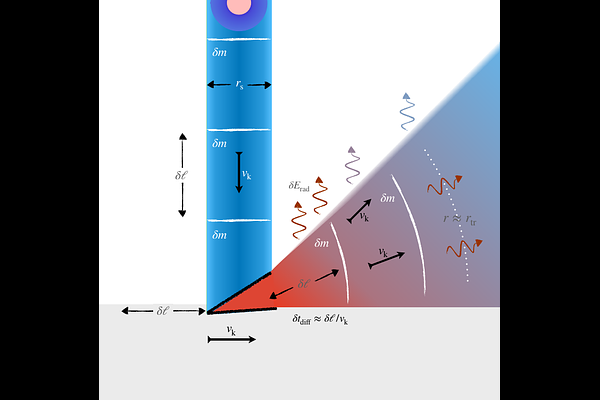QPEs from EMRI Debris Streams Impacting Accretion Disks in Galactic Nuclei

QPEs from EMRI Debris Streams Impacting Accretion Disks in Galactic Nuclei
Itai Linial, Brian D. Metzger, Eliot Quataert
AbstractQuasi-periodic eruption (QPE) sources in galactic nuclei are often associated with a stellar object orbiting a supermassive black hole with hours-days period, brought in as an extreme mass-ratio inspiral (EMRI). In the presence of an accretion disk, repeated star-disk collisions lead to ablation of a small fraction of the stellar mass during each disk passage. We analytically follow the evolution of the stellar debris as it is tidally stretched outside the EMRI's Hill sphere, forming an elongated, dilute stream, that subsequently collides with the disk, half an orbit after the previous star-disk encounter. At sufficiently long orbital periods ($\gtrsim 12$ hr), the stream is too dilute to penetrate the disk, and is instead strongly shocked and deflected at its surface through a reverse shock. We obtain the resulting emission and explore implications for QPE observations. Due to their low optical depth and prolonged interaction time, radiation from the shocked streams typically dominates over that from shocked disk gas directly impacted by the star or by ejecta confined within its Hill sphere, as was first proposed by Yao et al. 2025. We find that: (1) QPE flare durations reflect the stream-disk collision timescale; (2) Flare luminosities of $10^{42-43}$ erg/s, consistent with observed QPEs, are robustly produced; (3) Soft X-ray flares with temperatures of ${\sim}$100 eV arise when the stream mass is sufficient to sustain a radiation mediated shock at the collision interface. Higher mass streams yield softer flares, typically outshone by the disk, while lower mass streams result in collisionless shocks, which likely produce fainter and harder flares. We discuss observational implications of the temporal evolution of the underlying disk, assuming it is the remnant of a prior tidal disruption event in the same galaxy.